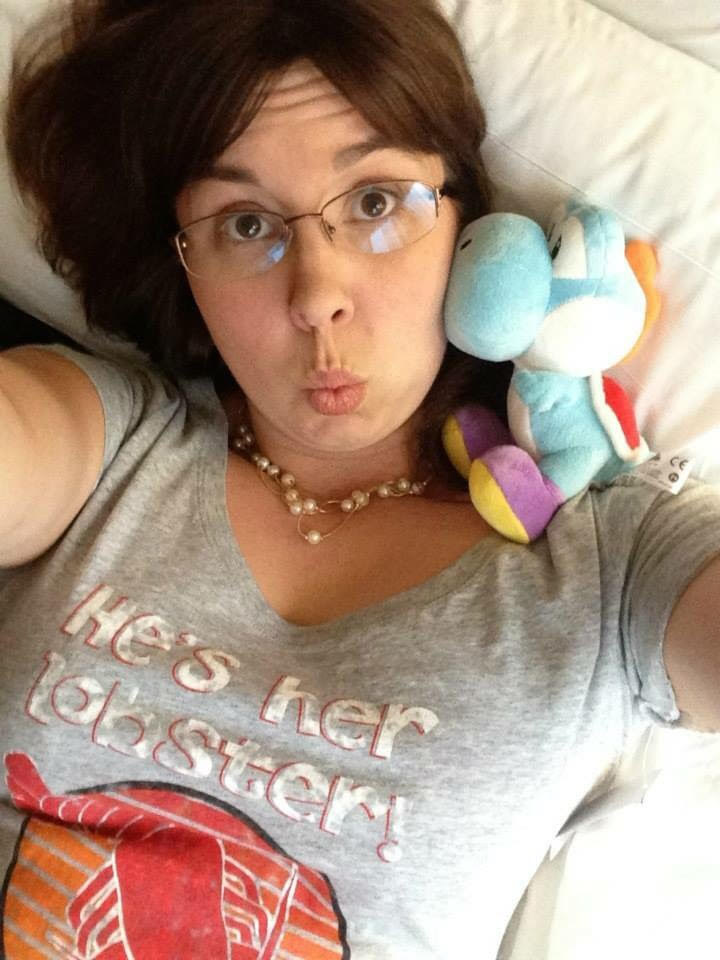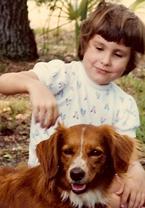Ever wondered what goes on behind the scenes at Girl Museum? What goes into making the online museum that you know and love? Well look no further, because our team at Girl Museum have kindly offered to give us an insight into their lives and what they do to make the Girl Museum world go around…
Next on our list it‚Äôs the formidable Tiffany Rhoades who has been our Program Developer for the past 4 years…

Tiffany Rhoades showing her gamer girl love.
How did you first get involved with Girl Museum? What was it that made you want to be a part of Girl Museum?
I got involved kind of on accident. I was in graduate school, looking for a way to fulfill my internship requirement for an MA in Public History. I was able to fulfill half the requirements by working at a local historic site in the same town as my university, but I needed somewhere else to fulfill the rest. I stumbled across Girl Museum in a Google search, and saw that they had an internship program. So the first thing was that it was virtual and something I could do. But I also loved the focus on young girls – it was unique, and at the time, I saw an organization just getting its feet wet, so to speak. There was a lot of potential, and it sounded like a group of women who were really passionate about their topic. So I applied, got to talking with Ashley, and started work I think as a Development Intern.
After my internship of five months, Ashley invited me to stay on as a volunteer. I did, and the rest is – as they say – history.
As Program Developer what does a typical Girl Museum day look like for you?
Oh boy. Is there a typical day? I’d say what I do the most is checking emails, keeping up with our Facebook page, and dealing with anything that comes in through that. Since I work full-time in higher education, my weekdays are mostly about keeping up with our Junior Girls to make sure everything’s going well. So that includes filtering new applications, providing feedback or answering questions about projects, keeping up with any industry trends that we need to be aware of, and just making sure that things are running smoothly.
I typically dedicate a weekend day to doing the more in-depth stuff. This includes producing the podcast, writing or reviewing for exhibitions, doing website updates and backups, etc. Sometimes I will Skype with Ashley, Katie, or a Junior Girl to touch base on projects or welcome someone new to the team. When I didn’t have a job (for a good 3 year span of time), I did a lot more on a daily basis, but now with a full-time job and family I’ve cut back considerably.
How do you choose the themes of your online exhibitions?
By asking what we like. Every team member brings something unique – an interest, a field of study, even a story. One of the first questions I ask new Junior Girls is, “What do you love?” What makes them jump out of bed. What did they write for a major paper or dissertation? What books can they not put down? That kind of thing.
Sometimes, our themes kind of come to us. One year, we decided to do all science-related exhibits. A lot of news was focusing on girls in STEM fields, so we wanted to explore that. STEM Girls and STEAM Girls were born out of that, largely led by our wonderful Education Advisor, Hillary, who has a huge interest in science and history. At the same time, Gamergate was happening – something I was intensely passionate about, as a lifelong gamer – and so I asked to top off the theme with Gamer Girl, which explored a specific STEM field that was also very focused on social justice. Ideas come from a variety of sources – our lead team, our interns, or even volunteers or collaborators who reach out to us.
That’s really how it works best – we follow our passions, and those lead us to the themes.
Why do you think it is important to have such heterogeneous displays?
Because girls don’t just love art, or archaeology, or history. They aren’t just present in those things. Girls are everywhere, and our audience is everywhere. And one of the things I was taught early on, the tenets I live by, is to meet your audience where they’re at. Don’t force someone who likes comics to sit through an “old masters” art exhibit. Instead, help them fall in love with comics all over again. Museums tend to stick by what their collections have been – and these categories that people seem to think are the only thing museums do. Museums can be so much more than that! They’re places to fall in love, to discover something new, to get passionate and emotional and have meaningful experiences.
The most meaningful experiences in my life have been because someone took something I already loved, and made it unique and new and fun again. They showed me something I never knew. So I, personally, don’t ever want to impose limits on what we cover as far as themes. There’s an entire world, an incredibly rich history and culture of human experience out there to explore. And girls have been a part of every single bit of it. Imposing limits just means that one day you’ll find an end point. I don’t ever want to find that – I want to keep going, to keep exploring, and to keep telling all these incredibly rich and diverse stories. One story can save a life, can change a heart or mind, or even the world. I want to tell all the stories we can.
Do you have a favourite exhibition from the Girl Museum catalogue? If so, then why?
I’m pretty biased here, as I’ve produced quite a few of them. Surfer Girl was my first big show, and I think it’ll always have a big place in my heart – it was my first community collaboration, and it really brought together a lot of diverse people into one exhibit, to tell a story that hadn’t been told before (the importance of girls in surfing history).
It was also an intensely personal one – I grew up in Florida and despite not being comfortable in the water, I have a love affair with the ocean (including surfing). I always wanted to explore it more, and getting to talk to students, scholars, and surf professionals around the world enabled me to pursue that passion and really learn all I could about it. I have a tremendous amount of respect for the guts it takes surfer girls to do what they do and get through the insane amount of media and body image pressure. They are truly an amazing group of individuals, and Surfer Girl really showcased that while enabling me to produce an exhibit the way I had always wanted: by letting the people of that community tell it, rather than having some big curatorial voice dictate it.

Stay tuned for our next interview with the seasoned Katie Weidmann, Social Media Manager and editorial guru!
-Rebecca King
Junior Girl
Girl Museum Inc.
